
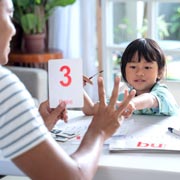 Concepts involving numbers and counting can sometimes be tricky for some preschoolers to grasp. Making sense of such concepts is important, though, because many aspects of children’s day-to-day lives will require an increasing understanding of numbers as time passes. Whether it’s knowing if a quantity of something is more or less than something else, how much of an ingredient is required in a mixture, or what change to expect from a purchase, children will need to grasp number-based concepts — and understand their real-world applications. What’s more, they’ll need to do this sooner rather than later if they’re to thrive, not least when they leave early years settings to begin school.
Concepts involving numbers and counting can sometimes be tricky for some preschoolers to grasp. Making sense of such concepts is important, though, because many aspects of children’s day-to-day lives will require an increasing understanding of numbers as time passes. Whether it’s knowing if a quantity of something is more or less than something else, how much of an ingredient is required in a mixture, or what change to expect from a purchase, children will need to grasp number-based concepts — and understand their real-world applications. What’s more, they’ll need to do this sooner rather than later if they’re to thrive, not least when they leave early years settings to begin school.
Early parental help can significantly boost children’s understanding of numbers, counting, and maths terminology. One of the key ways to help preschoolers is through number and counting games. What’s more, by using games and playful challenges, learning number and counting concepts will be fun! That fun element will be a key to both success and enjoyment. Indeed, learning through play is, as we know, the very best way for young children to learn. With that said, let’s take a look at some examples of games and fun challenges that under-fives can take part in. With supervision and guidance from adults, these are a great way to boost comprehension of number-based concepts in little ones — and support the EYFS curriculum.
First Create Some Number Cards
 Making ‘number cards’ with your child will be a fun and useful first step. These could be as simple as small pieces of paper or card, each having a single large number written clearly on them. Alternatively, your child could take the opportunity to get more creative. For example, you and your child could make the numbers bright and colourful, have patterned in-fills, or even be made to look like animals or number ‘characters’ that have eyes. For the very young, start with numbers up to 5, or go to 10 or even 20 for older and more advanced children. Size-wise, perhaps aim for cards sized at about A6 (a quarter of an A4 sheet) or even A7 (A4 divided into 8).
Making ‘number cards’ with your child will be a fun and useful first step. These could be as simple as small pieces of paper or card, each having a single large number written clearly on them. Alternatively, your child could take the opportunity to get more creative. For example, you and your child could make the numbers bright and colourful, have patterned in-fills, or even be made to look like animals or number ‘characters’ that have eyes. For the very young, start with numbers up to 5, or go to 10 or even 20 for older and more advanced children. Size-wise, perhaps aim for cards sized at about A6 (a quarter of an A4 sheet) or even A7 (A4 divided into 8).
Number Order Games
Once you have a set of numbered cards, first ensure your child recognises the numbers and can say their names. Then, get your child to jumble them up. They should then place each card on the table or other flat surface and try to move them back into the correct numerical order. The idea is to end up with the lowest number on the left, going in order until they have correctly placed the highest number on the right. Ask them to count them out loud, from left to right, once complete. Praising and congratulating them when they do well will encourage them but, of course, help them if they struggle at first.
Once they’ve mastered the first game, make it more challenging by asking them to reverse the numbers and, when complete, count the numbers backwards.
Getting More Advanced
When your child becomes more advanced, perhaps shake things up a bit by hiding a number and seeing if they can tell you which one is missing. Later still, you could even miss out all the odd numbers, so they have to play the game with only even numbers, then do it the other way around. Learning to count all the odd or even numbers will be another useful and practical skill as they get older.
Number ‘Dot’ Cards
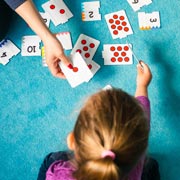 A more advanced form of the number cards could depict the correct number of dots (or other drawn objects) instead of — or as well as — the actual written number. So, for example, the ‘3’ card could show a column or row of 3 round dots or squares or even something like 3 drawn strawberries — whatever your child likes! In a way, it’s a bit like traditional playing cards where each has both a number and the right amount of hearts, diamonds, clubs or spades on it, to match the number.
A more advanced form of the number cards could depict the correct number of dots (or other drawn objects) instead of — or as well as — the actual written number. So, for example, the ‘3’ card could show a column or row of 3 round dots or squares or even something like 3 drawn strawberries — whatever your child likes! In a way, it’s a bit like traditional playing cards where each has both a number and the right amount of hearts, diamonds, clubs or spades on it, to match the number.
The benefit of this, more advanced type of card is that children will be able to see (and count), for example, two ‘dots’ on a ‘2’ card, four on a ‘4’ card, and so on. By using this approach, children will have a visual clue and practical example of the number’s meaning and, crucially, it will allow them to recognise and better understand quantities.
Introduce Simple Addition & Subtraction
When your child is more advanced using their number cards, a gradual introduction to simple addition and subtraction concepts will come easier — particularly if they use the cards with the numbers depicted with the dots/symbols. So, when you ask them what happens when they add a 2 and a 3 together, they will be able to count (or, with practice, recognise) the quantity of symbols on both cards. Before long, they’ll grasp the underlying concepts and be able to do it in reverse (subtraction). You could also consider adding mathematical ‘symbol’ cards into the pack, for example, ‘plus’ and ‘minus’ symbol cards.
Ensure you give your child a round of applause when they get things right in any of these games — it will give them encouragement to keep going and also give them a sense of progress and achievement. Consider awarding them a prize or sticker to celebrate their achievements.TIP:
Number Matching Games
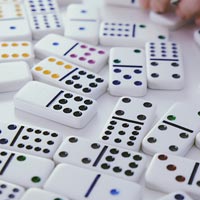 This next game will require a set of dominoes or, if you don’t have a set, they’re also easy enough to make in a similar way to the number cards. As you may know, each half of every domino has a number of dots, most commonly from 1 to 6. So, for example, there might be two dots on one end and five on the other, with the dot formations being rather like those you’d see on dice.
This next game will require a set of dominoes or, if you don’t have a set, they’re also easy enough to make in a similar way to the number cards. As you may know, each half of every domino has a number of dots, most commonly from 1 to 6. So, for example, there might be two dots on one end and five on the other, with the dot formations being rather like those you’d see on dice.
Whether using real dominoes or a homemade paper alternative, this game is traditionally played with 2 people. However, for the purpose of today’s game, it can be played just as well by a solo child, although under-fives will benefit most if they have some adult supervision and feedback. The idea of the game is to lay down one domino. Then, the next domino will need to be laid alongside one end of it so that the touching numbers match. So, for example, if the first domino has a 2 at one end and a 5 at the other, the second domino will need to have at least one number that matches and that should be placed so the two matching numbers touch. This is repeated so more and more dominoes are added, each time with a matching number connecting to an existing domino. Although traditionally there is a winner and a loser in dominoes, if playing solo, the idea here is simply for children to learn to easily recognise the number of dots. It’s a great way for children to be able to instinctively know whether they are looking at 1, 2, 3, 4, 5 or 6 dots — recognising the quantity and associated number will become instinctive if they practise.
Quantity Estimating Games
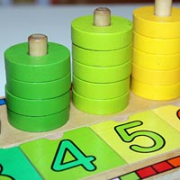 Understanding whether a quantity of something is more or less than something else is an important concept for children to grasp. Similarly, being able to estimate a quantity is a useful and practical skill for little ones to master. Such concepts can easily be highlighted, and the skills mastered, using simple estimating games. Some examples follow.
Understanding whether a quantity of something is more or less than something else is an important concept for children to grasp. Similarly, being able to estimate a quantity is a useful and practical skill for little ones to master. Such concepts can easily be highlighted, and the skills mastered, using simple estimating games. Some examples follow.
With the help of your child, build two stacks of one kind of object (e.g. draughts counters, biscuits, drinks coasters, etc.) and ask your child to confirm which stack they think has more than the other — without actually counting. Take some away or add some and repeat the process. They’ll soon be able to confirm the answers more accurately and grasp concepts like more, less, taller, shorter, and so on. This is a simple but practical game that will exercise children’s estimating skills and improve maths vocabulary.
Once they’ve mastered simple stacks of identical components one directly on top of another, you could make the game more challenging. There are a few ways to approach this.
- It can be achieved by making the stacks more complex, for example, in layers of different quantities — a pyramid format would be a good example.
- Or, instead of using a stack of near-identical components, try using small piles of irregular items, e.g. vegetables or fruit. Due to the different sizes and shapes, these will be more of a challenge and will get children thinking and concentrating harder.

As before, perhaps take away or add more objects to one or more of the groups and ask them to estimate which has more and which has less. Also, ask them to estimate, using logic, how many components each group has. You could even take it a step further by adding piles of objects to scales. Ask your child which they think is going to be heaviest, which is lightest, and so on.
Such games and challenges are a great workout for children’s young brains and great ways to introduce new number- and quantity-based concepts to children’s worlds, all in a fun way. They will also help little ones introduce new maths terminology into their vocabulary.
The Shop Game
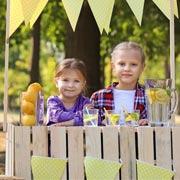 Pretending to be a shopkeeper or a shopper buying from one is a great next step for children. What’s more, they’ll naturally love playing shops having, no doubt, accompanied parents to real shops. This is where they can put all the things they’ve learned from the games above into practice. They can check they have the right quantities, weights or volumes or products, check they’re giving the shopkeeper the right amount of money, ensure that any change is correct — and so on! Playing shops is such a great way to master numbers, counting, estimating, weighing, addition, subtraction and more!
Pretending to be a shopkeeper or a shopper buying from one is a great next step for children. What’s more, they’ll naturally love playing shops having, no doubt, accompanied parents to real shops. This is where they can put all the things they’ve learned from the games above into practice. They can check they have the right quantities, weights or volumes or products, check they’re giving the shopkeeper the right amount of money, ensure that any change is correct — and so on! Playing shops is such a great way to master numbers, counting, estimating, weighing, addition, subtraction and more!
Numeracy Skills Boost Children’s Long-Term Outcomes!
We hope that today’s activity ideas, in the form of games, help your child to grasp maths terminology and number-based concepts like counting, subtracting, adding, comparing, and estimating. Learning through play is by far the best way for little ones to learn. And, by learning about the application of number concepts through games and activities, they will be able to experience real-life applications of them. It will naturally make more sense and make learning about numbers and counting child’s play!
What’s more, an early boost to numeracy skills has been proven to enhance outcomes for children even in the longer term. Studies show that the benefits of number mastery include a propensity to stay in education longer, better job prospects, and improved earning potential as adults. That’s the power of understanding numbers!
Little Cedars Nursery, Streatham

 At Little Cedars Nursery in Streatham, we also take every opportunity to help children learn about numbers, how they work, their significance to everyday life, and the maths vocabulary that surrounds them. It’s all an important part of the EYFS curriculum and something they’ll benefit from profoundly as they grow older – crucially too in readiness for school. If you would like to explore the possibility of your child attending this wonderful nursery and preschool in London SW16, please get in touch or simply apply for a place (see the options below). Little Cedars Nursery is officially a Good Provider and supports eligible children through various government-funded childcare schemes, including those for eligible babies from just 9 months.
At Little Cedars Nursery in Streatham, we also take every opportunity to help children learn about numbers, how they work, their significance to everyday life, and the maths vocabulary that surrounds them. It’s all an important part of the EYFS curriculum and something they’ll benefit from profoundly as they grow older – crucially too in readiness for school. If you would like to explore the possibility of your child attending this wonderful nursery and preschool in London SW16, please get in touch or simply apply for a place (see the options below). Little Cedars Nursery is officially a Good Provider and supports eligible children through various government-funded childcare schemes, including those for eligible babies from just 9 months.
As well as being perfectly located for families looking for nurseries in Streatham, Streatham Common, Streatham Park and Streatham Hill, we may also suit those seeking high-quality childcare near Tooting, Furzedown, Balham, Norbury and Colliers Wood.



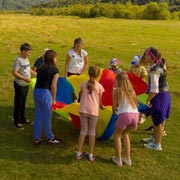 Watch any infant, toddler or preschooler for just a few minutes and you’ll see that one thing comes naturally to them; play. Indeed, it’s as if they’ve been programmed that way, with the need to play coming instinctively to youngsters, whatever their species. Aside from it simply being great fun, there are a multitude of very good reasons for that — play teaches them an enormous amount about each other, themselves, other living things, cause and effect, and the world around them. It also allows them to learn and fine-tune a whole swathe of new skills as they grow older, play new games, and become more experienced. Add in some careful steering and nurturing during that play from Mum or Dad and they have a real recipe for success. With that in mind, we look today at the key ways in which learning through play profoundly benefits children.
Watch any infant, toddler or preschooler for just a few minutes and you’ll see that one thing comes naturally to them; play. Indeed, it’s as if they’ve been programmed that way, with the need to play coming instinctively to youngsters, whatever their species. Aside from it simply being great fun, there are a multitude of very good reasons for that — play teaches them an enormous amount about each other, themselves, other living things, cause and effect, and the world around them. It also allows them to learn and fine-tune a whole swathe of new skills as they grow older, play new games, and become more experienced. Add in some careful steering and nurturing during that play from Mum or Dad and they have a real recipe for success. With that in mind, we look today at the key ways in which learning through play profoundly benefits children. Play and creativity go hand-in-hand. Whether making up a new game, role-playing, constructing, or playing in a den, children will naturally create both scenarios and physical items as part of their play. Such activities teach them how to use their imaginations and to be creative — in a myriad of ways.
Play and creativity go hand-in-hand. Whether making up a new game, role-playing, constructing, or playing in a den, children will naturally create both scenarios and physical items as part of their play. Such activities teach them how to use their imaginations and to be creative — in a myriad of ways. Different play activities require different types of movement and physical interaction from children. Indeed, this is a fundamental aspect of play. Whether jumping and running with large movements or carefully constructing with small items like building blocks, children will naturally hone both fine and gross motor skills during play. Such physical skills are essential to their ability to navigate and interact with the world around them and, in the most natural of ways, play is at the heart of enhancing those abilities.
Different play activities require different types of movement and physical interaction from children. Indeed, this is a fundamental aspect of play. Whether jumping and running with large movements or carefully constructing with small items like building blocks, children will naturally hone both fine and gross motor skills during play. Such physical skills are essential to their ability to navigate and interact with the world around them and, in the most natural of ways, play is at the heart of enhancing those abilities. Social skills are also improved through play. Children naturally play with other children and, by so doing, will soon pick up social skills as they begin to better understand social protocols that allow them to succeed both as individuals and in groups. Decent manners, saying please and thank you, cooperation, teamwork and closer bonding are all examples of social skills that can benefit through group play. Other examples include conflict resolution, better sharing, negotiation and communication, which we’ll come to next.
Social skills are also improved through play. Children naturally play with other children and, by so doing, will soon pick up social skills as they begin to better understand social protocols that allow them to succeed both as individuals and in groups. Decent manners, saying please and thank you, cooperation, teamwork and closer bonding are all examples of social skills that can benefit through group play. Other examples include conflict resolution, better sharing, negotiation and communication, which we’ll come to next. Through all this play, children will be communicating with each other and with any adults that are supervising. As such, play is a great facilitator of communication. Indeed, good communication is essential to most games and, through it, children can cooperate and achieve in ways that will help them in both the short term and into adulthood. Improving communication skills is also a fundamental way to improve success when you think about it.
Through all this play, children will be communicating with each other and with any adults that are supervising. As such, play is a great facilitator of communication. Indeed, good communication is essential to most games and, through it, children can cooperate and achieve in ways that will help them in both the short term and into adulthood. Improving communication skills is also a fundamental way to improve success when you think about it. Mathematics is often embedded into games and pastimes. Children can learn, for example, about adding, subtracting, multiplication and division through games. Even dividing group play into teams requires some fundamental maths to ensure teams are equal in size. Building towers out of blocks is another great example where children can count how many blocks they can stack into a tower before it falls over. They can try to beat their own maximum, or even compete against one another to see who can use the most blocks.
Mathematics is often embedded into games and pastimes. Children can learn, for example, about adding, subtracting, multiplication and division through games. Even dividing group play into teams requires some fundamental maths to ensure teams are equal in size. Building towers out of blocks is another great example where children can count how many blocks they can stack into a tower before it falls over. They can try to beat their own maximum, or even compete against one another to see who can use the most blocks. Play comes in a vast array of different forms, shapes, and sizes. Through so doing, it introduces children to countless scenarios, situations, and challenges. By immersing children into such widely differing environments, they learn huge amounts about the world around them, and everything within it. Whether it’s newfound knowledge about a new object, material, place, culture, activity, or something else, play is an amazing conduit to new knowledge and the need to learn new skills. Play is the ultimate educator and the incredible thing is that children may be unaware that they’re learning — they’re having too much fun!
Play comes in a vast array of different forms, shapes, and sizes. Through so doing, it introduces children to countless scenarios, situations, and challenges. By immersing children into such widely differing environments, they learn huge amounts about the world around them, and everything within it. Whether it’s newfound knowledge about a new object, material, place, culture, activity, or something else, play is an amazing conduit to new knowledge and the need to learn new skills. Play is the ultimate educator and the incredible thing is that children may be unaware that they’re learning — they’re having too much fun!
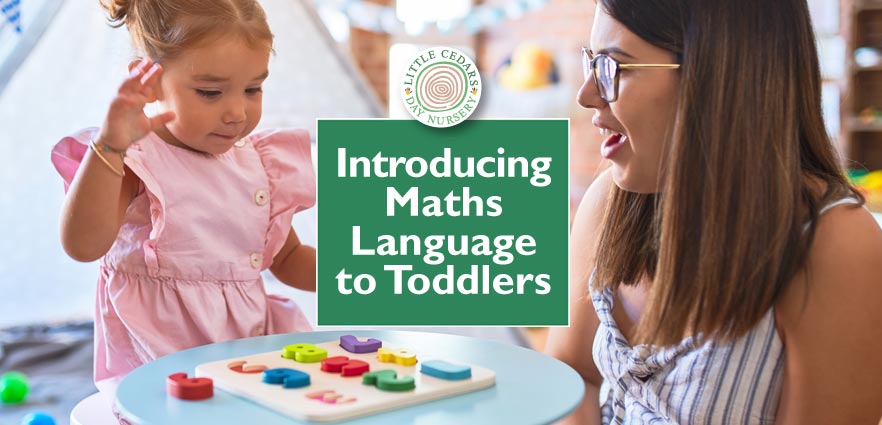
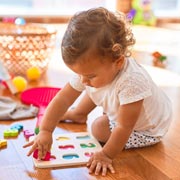 However, many children struggle with maths and have negative attitudes towards the topic. To prevent this, it is important to introduce maths concepts and vocabulary to children at a young age. Fortunately toddlers are at a period of development where they can learn and understand a range of maths words and concepts when given the opportunity. And, by introducing mathematical concepts and vocabulary to toddlers in a fun and engaging way, adults can help children develop a strong foundation in maths and foster a positive attitude towards the subject.
However, many children struggle with maths and have negative attitudes towards the topic. To prevent this, it is important to introduce maths concepts and vocabulary to children at a young age. Fortunately toddlers are at a period of development where they can learn and understand a range of maths words and concepts when given the opportunity. And, by introducing mathematical concepts and vocabulary to toddlers in a fun and engaging way, adults can help children develop a strong foundation in maths and foster a positive attitude towards the subject. Introducing maths words and language to toddlers is all part of
Introducing maths words and language to toddlers is all part of 
 Parents and caregivers can help toddlers learn maths words and maths-related language in a variety of ways. General examples include:
Parents and caregivers can help toddlers learn maths words and maths-related language in a variety of ways. General examples include: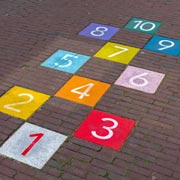 Number Hopscotch
Number Hopscotch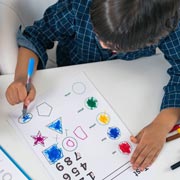 Parents can create simple patterns using objects such as blocks, toys, or coloured pencils, and ask toddlers to continue the pattern. This activity can help toddlers develop their pattern recognition skills and understand basic maths concepts such as repetition and sequencing.
Parents can create simple patterns using objects such as blocks, toys, or coloured pencils, and ask toddlers to continue the pattern. This activity can help toddlers develop their pattern recognition skills and understand basic maths concepts such as repetition and sequencing. Introducing maths words and concepts to toddlers is an important step in fostering their overall learning and development as well as in relation to success in mathematics itself. By teaching toddlers maths vocabulary and concepts at a young age, we can help them develop strong foundations in maths, enhance their cognitive development and language skills, and improve their attitudes towards maths. It is never too early to start introducing maths concepts to children, and by doing so, we can help them develop a lifelong appreciation of maths as well as nurturing a strong foundation for future success in many areas of their lives.
Introducing maths words and concepts to toddlers is an important step in fostering their overall learning and development as well as in relation to success in mathematics itself. By teaching toddlers maths vocabulary and concepts at a young age, we can help them develop strong foundations in maths, enhance their cognitive development and language skills, and improve their attitudes towards maths. It is never too early to start introducing maths concepts to children, and by doing so, we can help them develop a lifelong appreciation of maths as well as nurturing a strong foundation for future success in many areas of their lives.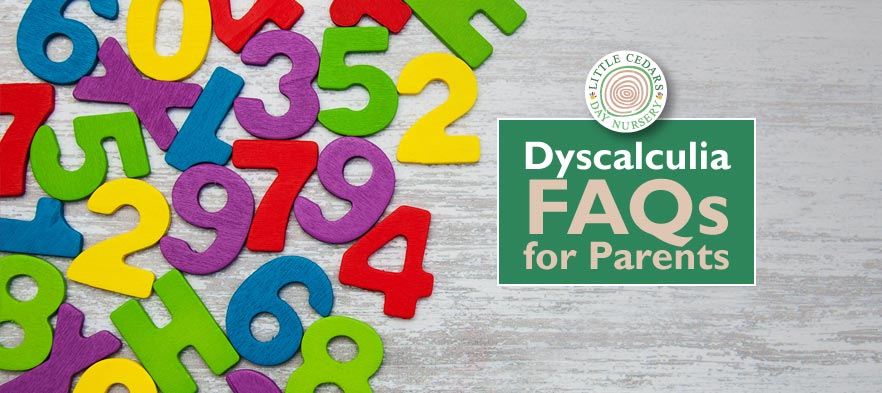
 In today’s guide, we answer frequently asked questions (FAQs) about Dyscalculia, particularly in relation to children, including preschoolers. Around 5% of children of school age are thought to have dyscalculia.
In today’s guide, we answer frequently asked questions (FAQs) about Dyscalculia, particularly in relation to children, including preschoolers. Around 5% of children of school age are thought to have dyscalculia. A few of the possible signs of dyscalculia include:
A few of the possible signs of dyscalculia include: They may also continue to use fingers to count long after their contemporaries have moved on to mental counting;
They may also continue to use fingers to count long after their contemporaries have moved on to mental counting; Just as with dyslexia, there is no cure for dyscalculia. However, there are many ways to help children cope with its effects. It’s also worth bearing in mind that children with dyscalculia can be very gifted in other areas, for example creativity, strategic thinking, problem solving, practical abilities and often great intuition.
Just as with dyslexia, there is no cure for dyscalculia. However, there are many ways to help children cope with its effects. It’s also worth bearing in mind that children with dyscalculia can be very gifted in other areas, for example creativity, strategic thinking, problem solving, practical abilities and often great intuition.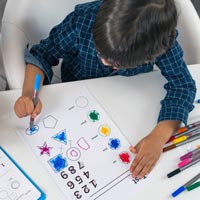 They can also benefit when important words and numbers are highlighted (to draw attention to their importance);
They can also benefit when important words and numbers are highlighted (to draw attention to their importance); Childcare professionals at Little Cedars Nursery will look out for possible signs of dyscalculia — and any other learning difficulties — as a matter of course. If we spot anything, we’ll liaise with parents, guardians or carers to discuss ways in which we can all help, together. There are many ways to help children with learning difficulties. That’s true whether they’re at the nursery, at home, or when they are ready to move on to school. Helping children with challenges and any special educational needs is all part of the service at Little Cedars Nursery, Streatham. Indeed, one of our main goals is to help each child become the very best version of themselves.
Childcare professionals at Little Cedars Nursery will look out for possible signs of dyscalculia — and any other learning difficulties — as a matter of course. If we spot anything, we’ll liaise with parents, guardians or carers to discuss ways in which we can all help, together. There are many ways to help children with learning difficulties. That’s true whether they’re at the nursery, at home, or when they are ready to move on to school. Helping children with challenges and any special educational needs is all part of the service at Little Cedars Nursery, Streatham. Indeed, one of our main goals is to help each child become the very best version of themselves.